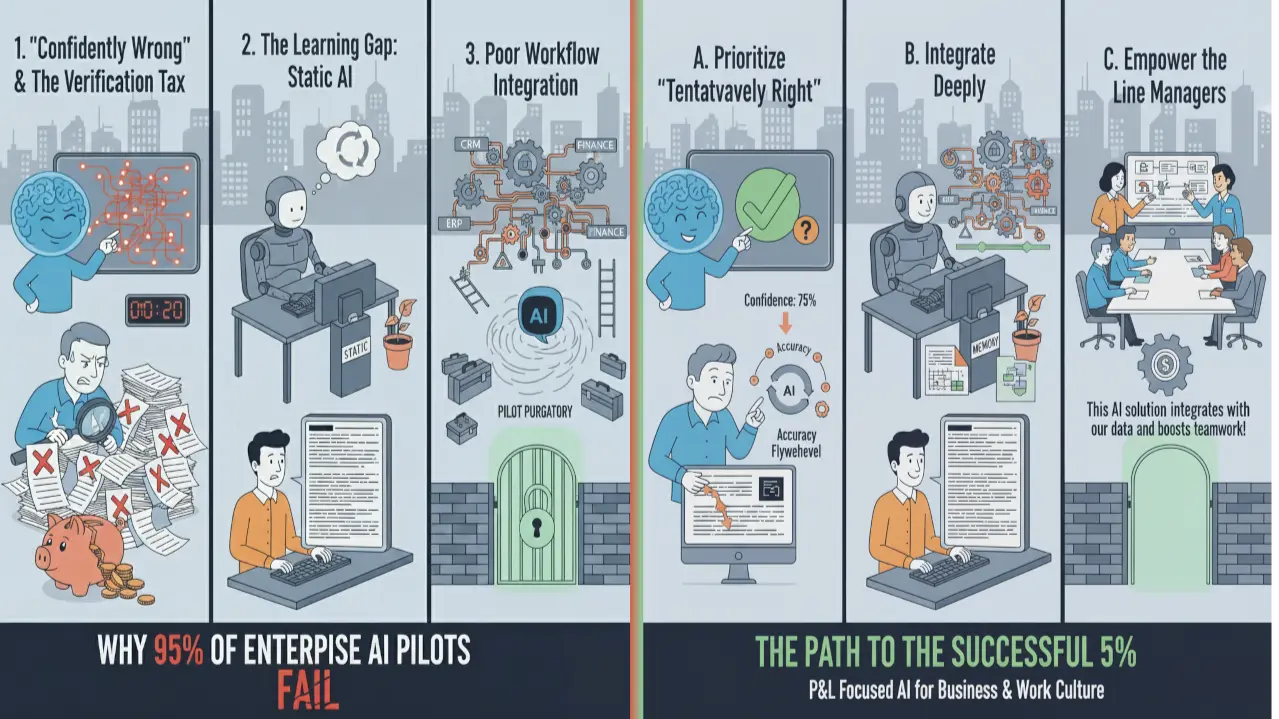The Path to the Successful 5% in AI Adoption
A recent MIT-Report “The GenAI Divide STATE OF AI IN BUSINESS 2025” from July 2025revealed a striking statistic: 95% of enterprise Generative AI (GenAI) pilots fail to deliver a measurable Return on Investment (ROI). This is despite companies having vast resources and highly skilled teams.
Pls also take note of this related articleThe GenAI Divide: Deconstructing the 95% AI Failure Rateputting the bold headline of the original report and all the media-coverage into perspective.
For technology leaders, this finding is a clear signal. The failure is not about lacking money or talent; it’s about a fundamental misunderstanding of what makes AI valuable in a business setting. Success hinges on strategic implementation - which means understanding the specific workflows and high-quality data required - not on raw computational power or simply buying the latest "shiny tools."

🚧 The Core Barriers to Business Value
Why are billions of dollars in AI investment yielding such poor returns in the majority of cases? The MIT analysis points to three key organizational and technical gaps:
1. The “Confidently Wrong” Problem (The Verification Tax)
Most AI tools are designed to provide answers with high confidence, even when the information is incomplete or outright incorrect. This creates a**“verification tax.”**
Instead of saving time, employees must spend extra hours forensically checking every AI output to avoid costly mistakes. This loss of time negates the efficiency gains, destroys trust, and ultimately causes the ROI to disappear, forcing teams back to older, human-centric workflows.
2. The Learning Gap: AI That Does Not Adapt
The majority of enterprise AI tools are static. They lack memory and adaptability.
If a system does not retain feedback, learn from human corrections, or adapt to the user’s changing context, it forces the user to repeat the same detailed prompt every time. This kills motivation to improve the system and prevents the AI from becoming truly valuable for mission-critical tasks. Simply put: if the system doesn't learn, it doesn't scale.
3. Poor Workflow Integration
For an AI system to move past the pilot phase, it must integrate deeply into existing business processes, data, and controls. Many generic tools are easy for individuals to use (like a general chatbot), but they fail to plug into existing enterprise systems (such as CRM or ERP platforms).
Tools that do not fit the specific approval chains and data flows of an organization will sit in "pilot purgatory" and never achieve widespread, impactful deployment. Successful adoption is fundamentally about integration , not tool adoption.
🦵 The Essential First Step to the 5%: Start with a Single Problem
Before diving into the detailed strategy, the single most important first step for an agile AI strategy is to identify and isolate a single, high-value workflow problem by engaging directly with your frontline teams.
This initial step is the foundation for avoiding "pilot purgatory" and joining the successful 5%. It directly counters the main reasons AI pilots fail: misalignment with day-to-day operations and a vague ROI target.
How to Execute This First Step
To ensure your first AI initiative is grounded in P&L impact, follow these guidelines:
- Go to the Source (Your Teams): Engage directly with client-service and product teams. Ask them: "What is the most time-consuming, repetitive task you do that requires constant double-checking?" This helps pinpoint where the "verification tax" is highest.
- Prioritize "Boring" over Flashy: While front-office functions like sales are tempting, the reports show that the most dramatic and sustainable ROI often comes fromback-office automation (e.g., operations, finance, document processing). These areas usually have clearer, measurable cost-reduction metrics.
- Define Success Before a Single Tool is Vetted: Quantify the problem and the goal from the start. Instead of framing the goal as, "Let's use AI," define it as: "Our team spends 40 hours per week categorizing support tickets. Success for this AI pilot is reducing that by 75% within 90 days." This immediately establishes a clear P&L goal.
